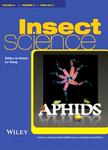版权所有:内蒙古大学图书馆 技术提供:维普资讯• 智图
内蒙古自治区呼和浩特市赛罕区大学西街235号 邮编: 010021

作者机构:Hainan Univ Sch Trop Agr & Forestry Sch Agr & Rural Sch Rural Revitalizat Haikou Peoples R China Hainan Univ Sanya Inst Breeding & Multiplicat Sch Breeding & Multiplicat Sanya Peoples R China Fujian Agr & Forestry Univ State Key Lab Agr & Forestry Biosecur Fuzhou Peoples R China Fujian Agr & Forestry Univ Dept Plant Protect Fujian Prov Key Lab Insect Ecol Fuzhou Peoples R China
出 版 物:《INSECT SCIENCE》 (Insect Sci.)
年 卷 期:2025年第0期
页 面:2025 Jan 19页
核心收录:
学科分类:0710[理学-生物学] 07[理学] 09[农学]
基 金:Hainan Provincial Natural Science Foundation of China National Natural Science Foundation of China Fujian Agriculture and Forestry University Scientific and Technological Innovation Program [KFb22012XA] Hainan University Foundation [RZ2200001469] ZDKJ202002 ZDYF2023XDNY075
主 题:Octodonta nipae serpin serine protease cathepsin-L phenoloxidase cascade
摘 要:Serpins (serine protease inhibitors) constitute a superfamily of proteins with functional diversity and unusual conformational flexibility. In insects, serpins act as multiple inhibitors, by forming inactive acyl-enzyme complexes, in regulating Sp tzles activation, phenoloxidases (POs) activity, and other cytokines. In this study, we present the cloning and characterization of Octodonta nipae serpin2 (OnSPN2), a 415 residues protein homologous to Tenebrio molitor 42Dd-like. Notably, OnSPN2 features an arginine residue (R364) at the P1 position, and additional arginine residues (R362, R367) at the P3 and P3 positions, respectively which is crucial for protease inhibition. Immunohistochemistry (IHC) and Western blot analyses revealed that OnSPN2 is primarily synthesized in plasmatocytes and then released into the plasma to exert its function. RNA interference results indicated that OnSPN2 knockdown may depress serine protease in melanization and remarkably increase the transcript level of Attacin in hemolymph, but its messenger RNA levels were not changed upon immune induction. Reciprocal co-immunoprecipitation assay results confirmed that OnSPN2 binds to OnPPAF1 and OnSP8, indicating its role as a negative regulator in the PO and AMP pathway. Intriguingly, several cathepsin-L isoforms were identified in the OnSPN2 immunoprecipitated samples. The cathepsin-L inhibition assays and protein-protein docking results, identified cathepsin-L as a potential target of OnSPN2. These results indicate that OnSPN2 is produced as an intracellular resident and additionally is associated with the PO and AMP pathway. OnSPN2 represents a multiple defense tool that may provide multiple antiproteolytic functions.